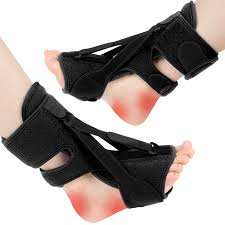Discover how a plantar fasciitis brace can relieve heel pain, support recovery, and improve foot comfort. Learn the benefits, usage, and tips for choosing the right brace for your needs.
Plantar fasciitis is one of the most common causes of heel pain, affecting millions of people worldwide. It occurs when the thick band of tissue connecting your heel bone to your toes — known as the plantar fascia — becomes inflamed. The result is sharp, stabbing pain, especially during the first steps in the morning or after long periods of standing. Thankfully, a plantar fasciitis brace offers an effective, non-surgical solution to ease discomfort and promote healing.
What Is a Plantar Fasciitis Brace?
A plantar fasciitis brace, sometimes referred to as a night splint or support brace, is designed to keep your foot in a dorsiflexed position — meaning your toes are pointed upward — while you sleep or rest. This gentle stretch maintains tension on the plantar fascia, preventing it from tightening overnight and reducing that intense morning pain.
There are various types of braces available, including soft, adjustable, and rigid designs. The choice often depends on the severity of your symptoms and your comfort preference.
How a Plantar Fasciitis Brace Helps
The primary purpose of a plantar fasciitis brace is to reduce inflammation, relieve pain, and encourage proper healing of the fascia tissue. Here’s how it works:
- Provides Continuous Stretch: By keeping your foot flexed, the brace stretches the plantar fascia and Achilles tendon, helping to prevent micro-tears that occur during rest.
- Supports Arch Stability: Many braces come with built-in arch support, which distributes pressure evenly across the foot and reduces strain on the heel.
- Enhances Recovery: Regular use of a brace can shorten recovery time by maintaining the right foot alignment and supporting the healing process.
- Improves Mobility: Over time, consistent brace use can restore natural foot movement and reduce dependence on pain medication.
When Should You Use a Plantar Fasciitis Brace?
A brace is most effective when worn during the night, as plantar fasciitis symptoms tend to worsen after hours of inactivity. Some braces are also designed for daytime use, providing gentle support while walking or standing.
If you experience severe heel pain upon waking or after sitting for long periods, incorporating a plantar fasciitis brace into your routine could make a significant difference.
Choosing the Right Brace
When shopping for a plantar fasciitis brace, consider the following factors:
- Comfort: Look for breathable, padded materials to prevent irritation.
- Adjustability: A brace with adjustable straps allows you to customize tension levels.
- Support: Choose a model that provides firm yet gentle stretching for your foot arch and Achilles tendon.
- Ease of Use: It should be simple to put on, remove, and clean.
- For expert diagnosis and treatment guidance, consult a podiatrist or orthopedic specialist. Medical facilities like drkelkarhospital.com offer professional assessment and treatment plans for plantar fasciitis, including brace recommendations tailored to individual needs.
Additional Home Remedies
While a plantar fasciitis brace is highly beneficial, combining it with other home treatments can further improve outcomes. Stretching exercises, ice therapy, supportive footwear, and anti-inflammatory medications (as prescribed by your doctor) can all complement brace use.
Final Thoughts
Living with plantar fasciitis doesn’t have to mean constant pain and discomfort. A well-chosen plantar fasciitis brace can make a remarkable difference by easing pain, promoting healing, and allowing you to return to your daily activities with confidence. With the right support and professional care, you can take firm, pain-free steps toward recovery.





